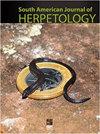两种共分布巴塔哥尼亚蜥蜴分支的表型和地理变异(鳞目,Liolaemini)
IF 0.7
4区 生物学
Q4 ZOOLOGY
引用次数: 0
摘要
摘要选择压力在物种分布范围内变化,因此有利于不同的表型。气候梯度尤其对生物体的生态和生理性能产生选择作用,这通常会促进形态变异。在气候条件恶劣的巴塔哥尼亚地区,Phymaturus和Liolaemus的姐妹属包括几个广泛分布的分支。一个例子是Liolaemus bibroni复合体和Phymatrus patagonicus分支;这些谱系在形态特征和生活史策略上都有所不同。共同分布的物种可能同样受到共同环境变量的影响,这些变量在其分布中占主导地位,包括形态变异模式。在这项研究中,我们确定并比较了与地理分布相关的形态变异模式。我们在巴塔哥尼亚的整个分布中使用了L.bibroni复合体和P.patagonicus分支物种的体型和头部形状,并量化了形态变量与纬度和气候变量之间的关系。结果表明,在两个分支中,身体大小和头部形状在纬度和气候变量之间存在共同变化,但在具有不同生活史和进化特征的姐妹分支的共同分布代表中,这些变化并不遵循明显的形态变化模式。本文章由计算机程序翻译,如有差异,请以英文原文为准。
Phenotypic and Geographic Variation in Two Co-Distributed Patagonian Lizard Clades (Squamata, Liolaemini)
Abstract. Selective pressures vary throughout the range of a species distribution, thus favoring different phenotypes. Climate gradients in particular exert selection on the ecological and physiological performance of organisms, which often promotes morphological variation. In Patagonia, a region with harsh climatic conditions, the sister genera Phymaturus and Liolaemus include several widely co-distributed clades. One example is the Liolaemus bibronii complex and the Phymaturus patagonicus clade; these lineages differ in both morphological characteristics and life-history strategies. Co-distributed species may be similarly affected by shared environmental variables that predominate in their distributions, including patterns of morphological variation. In this study we identify and compare patterns of morphological variation in relation to geographical distribution. We used body size and head shape of species of the L. bibronii complex and the P. patagonicus clade throughout their distributions in Patagonia, and quantified the relationships between morphological variables with latitude and climatic variables. The results showed co-variation of body size and head shape between latitude and climatic variables in both clades, but these do not follow an evident pattern of morphological variation in co-distributed representatives of sister clades with different life histories and evolutionary characteristics.
求助全文
通过发布文献求助,成功后即可免费获取论文全文。
去求助
来源期刊
CiteScore
1.50
自引率
0.00%
发文量
10
期刊介绍:
The South American Journal of Herpetology (SAJH) is an international journal published by the Brazilian Society of Herpetology that aims to provide an effective medium of communication for the international herpetological community. SAJH publishes peer-reviewed original contributions on all subjects related to the biology of amphibians and reptiles, including descriptive, comparative, inferential, and experimental studies and taxa from anywhere in the world, as well as theoretical studies that explore principles and methods.

 求助内容:
求助内容: 应助结果提醒方式:
应助结果提醒方式:


